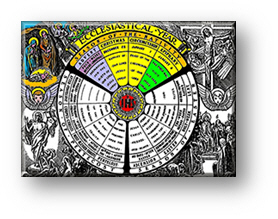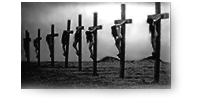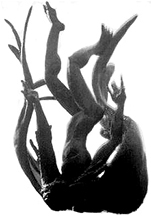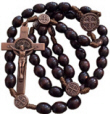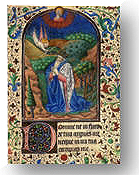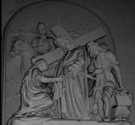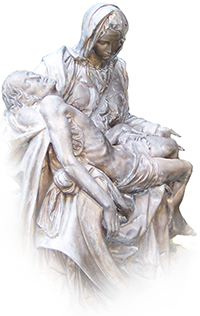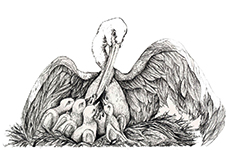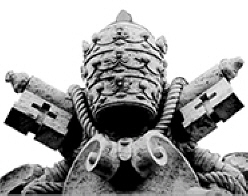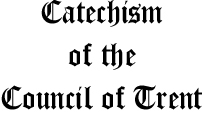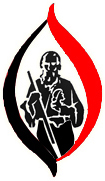|

The Tortures and Torments
of the Christian Martyrs
from
De SS. Martyrum
Cruciatibus
(a Modern Edition)
Chapter XI
Of other Tortures and means of Martyrdom:
-
Burying alive
-
Throwing into Rivers, Wells,
or Lime-kilns
-
Cutting open the Stomach,
and the like
The
tortures outlined above, in which
the martyrs were cast into deep ditches and buried with earth, hurled
into a running stream or into wells, or else into a lime-kiln, are found
in many Histories of Martyrdom, particularly those of Saints
Castullus, Vitalis, Marcellus, Philemon and his companions, Saints Paulina
and Daria, Roman virgins and martyrs, Saints Calistus and Carisius,
Saints Alexandra, Claudia, and Euphrasia, matrons, Julitta, virgin and
martyr, Saints Florus and Laurus, and many others. The two last named
are commemorated in the Menology on August 17th in these words:
“Anniversary of the
Blessed Martyrs, Saints Florus and Laurus. These holy men were twin
brothers, and hewers of stone, an art they had learned from Proclus
and Maximus. But after their masters had suffered martyrdom for
Christ’s sake, they left Byzantium (Constantinople) and retired
into the district of Illyricum, to the city of Ulpiani, where, working
in the quarries under Lido the Governor, they worthily followed
their trade. Finally, after enduring many tortures and being cast
by Licio into a deep well, they gave up their souls to God.”
The blessed martyrs were
also thrown sometimes into a lime-kiln, much as we find in the Acts
of St. Clement, Bishop of Ancyra, and also by the account of three
hundred martyrs given in the Roman Martyrology, on August
24th:
“At Carthage, anniversary
of three hundred Holy Martyrs in the time of Valerian and Gallienus.
Among other punishments, after the Governor commanded a lime-kiln
to be lighted and in his presence live coals and incense to be brought
forward, he said to the three hundred, ’Choose one of two things
— either burn incense to Jupiter on these coals, or be plunged into
the quicklime.’ Then, armed with faith and confessing Christ the
Son of God, they threw themselves with a quick dash into the fire,
and amid the vapors of the quicklime were instantly reduced to powder.
It is for this very reason that the white-clad host of Saints well
earned the title of the White Band.”
How
the Blessed Martyrs were Buried Alive
Before we proceed to other
points, it is important to note that Christians tortured in this manner
were not always cast bodily into pits to be buried entirely under earth
and stones, although this was generally the case. We read, for example,
in the Acts just cited, of Saints Philemon and Marcellus, that
these martrys for the faith were buried only up to their loins. We suggest
that you read their History for more on this point.
Of
the Different Ways that Christian Martyrs were Cast into the Sea or
into Rivers
As we mentioned above,
it was not always in one and the same, way that the martyrs were tormented
... but in many. Many of the Blessed Martyrs are recorded as having
been thrown into the waters. Sometimes this was done after great stones,
or lead weights, had been fastened to their neck or feet or right hand,
as
was the case with Saints Sabinus, Agapius, Florian, Alexandra, Claudia,
Euphrasia, matrons, Julitta, virgin, and others. At other times they
were cast into the waters with both hands and feet tied, wrapped in
a net, shut in leaden boxes, or sewn up in a bag. These methods are
to be found in the accounts of the martyrdoms of Saints Faustinus and
Jovita, as well as Saints Hermillus, Ulpian, Stratonicus, Nicostratus,
and others.
It is also noteworthy in this respect that the bag was a very
ancient form of punishment indeed. Plautus [254-184 B.C.] makes mention
of it in his Vidularia:
Iube hunc insui
culeo, atque in altum deportari, si vis annonam bonam
(“Order the man to be sewn up in a bag, and cast into the deep,
if you would have a good harvest ”).
Now the bag he speaks
of was a skin, or sack made of leather, in which murderers were sewn
up, often together with a dog, a cock, a snake, an ape, or some other
creature, and thrown headlong, in accordance with Roman law, into the
sea or river. From ancient times a law of this sort seems to have existed
in the case of parricides; and so Cicero states:
“If any man has killed
his parents or beaten them, and is found guilty and condemned on
that count, his head is to be wrapped in a wolf’s skin, wooden shoes
(that is, fetters) are to be put upon his feet, and he is to be
led to prison, and there to stay a little while the bag is being
made ready into which he must be placed and so cast into the water.”
In fact, this law was
passed by the Romans to terrify and so discourage others from following
the example of Lucius Hostius, who was the first of mankind, after the
War with Hannibal, to kill his own father, and was intended to dissuade
others from taking their own parents’ lives with the sword or otherwise.
Accordingly, when during the Cimbrian War (113-101 BC) Poblicius Malleolus
murdered his mother, he was punished in this fashion. His fate is mentioned
by Livy in these words:
“Poblicius Malleolus,
for the murder of his mother, was the first ever sewn up in a bag
and thrown into the sea”
And in another place:
“Malleolus was condemned
for his mother’s murder. After sentencing, his head was immediately
muffled in a wolf’s skin, while the bag was getting ready, into
which he was to be put and thrown into the water.”
At a later date Pompey
the Great [106-48 BC], when Consul, passed a law further amending the
ancient ordinance, extending the degree of relationship within which
murder involved this form of punishment, and detailing the creatures
to be enclosed in the bag’ along with the culprit — namely, a dog, a
cock, a viper, and an ape. The same law of Pompey’s is again recited,
with identical provisions, by Justinian in the Institutes. True,
this law fell into practical disuse in later Roman times by reason of
the cruelty of its provisions; but it was revived for the benefit of
the Christians, several of whom won their crown of martyrdom in this
strange fashion.
Of
Catholics cast by heretics into the Sea and Rivers, or Buried in the
Ground
Victor, Bishop of Utica,
in his Vandal Persecution describes how the Catholics were embarked
by their Heretic persecutors on board derelict ships, without sails
or oars, and so committed to the vast sea to confront certain shipwreck.
Nor is it only from the heretics that we learn of casting away Catholics
on the waters, but those of more modern times as well. We see this in
the Theatre of Cruelties:
“When the city of
Oudenarde in Flanders had been occupied by the host of the Gueux,
these insurgents captured all the priests of that province who were
noted for their piety and learning and carried them off to the castle.
Amongst these was one, Master Peter, a venerable old man and the
oldest of all the company. After heaping insults and doing violence
upon him, they stripped him of his clothes, bound his hands and
feet together behind his back, and threw him headlong through the
castle windows into the river, the good man crying out as he fell
with alert and undaunted spirit, ’Thy will be done, O, Lord.“ In
the same way, the venerable John Paul and the rest of the divines
were cast into the river, of whom Master James, the eldest and weakest
among them, unable to swim, was carried by the waters some way thence,
taken out, and his life saved.”
Again, somewhat further
down:
“Ursula, a Nun in
the Beguinage at Haarlem, (after her aged father, the acting magistrate
in that city, and several other well-reputed and well-born Catholics
with him, had been hanged) was herself led under the gallows, and
asked whether she would forsake her Faith and the Catholic Religion,
and marry a certain soldier. And when she steadfastly refused to
do so, she was at once cast into the water, and drowned.”
And yet again:
“The heretics of the
city of Nimes in Languedoc, after slaughtering a great multitude
of Catholics with their daggers, threw them, some dead, some still
half alive, into a well in the city, which was both wide and deep,
and filled it twice over to the brim.”
All this is to be found
in the book, The Theatre of Heretic Cruelties, in which we also
find the following concerning
Catholics who were buried in the earth:
“The Huguenots buried
alive a priest named Peter, of the parish of Beaulieu, leaving only
his head above ground. At a place in Belgium not far from
the Ypres, other clergy as well were thus covered with earth and
stones, and the Heugenots, setting up marks a short
way from their exposed heads, rolled bowls of stone or iron at them
in the way of sport.”
We will now continue to
explore still other sorts of tortures and torments to which our forebears
in Christ were exposed, first in the way of those martyrs who were publicly
stripped and led naked through the streets of cities; secondly of those
who were shut up in dungeons strewn with broken glass or shards of pottery
or even iron caltrops [triangular spikes], so that their bare bodies
would be lacerated and punctured by their sharp points, and last, those
who were tied to the branches of two trees and wrenched apart. After
this we will discuss (in Chapter XII) martyrs driven into banishment,
and those condemned to hard labor and to the mines.
The first and second kinds are attested by the Acts of the Blessed
Martyrs, Saints Alexander and Vincent, Peter and Marcellinus, Victor
and Corona, as in the Menology where, on September 9th, it is
recorded:
“Anniversary of the
Blessed Martyr Strato, who, being bound to two cedar trees and so
rent asunder in two parts for the faith of Christ, was made one
with the celestial host.”
Of other faithful servants
of Christ which were subjected to the same torture, Eusebius and Nicephorus
both bear witness, as well as the History of the martyrdom of
the above-named Saints Victor and Corona.
Of Catholics — particularly Monks
and Priests — who had their Stomachs Ripped Open by heretics within
this Present Century
Not only by the idolaters
of antiquity and heretics of former days have Christian martyrs been
torn apart and disemboweled in different ways (as we have already seen),
but no less by the heretics of our own day. Let us quote what is said
concerning this in the Theatre of Cruelties, and elsewhere:
“The Huguenots at
the Church of St. Macarius in Vasconia ripped the bellies of many
priests, and gradually drew out their bowels by winding them around
sticks which they turned around and around. In the city of Mancina,
having seized a priest of an advanced age, they proceeded to cut
off his privates, and after roasting them over a fire, crammed them
into his mouth. Then to see how he would digest them — for he was
still alive — they ripped open his stomach, consummating his martyrdom.
In the case of another priest, they imitated the tyranny and
cruelty of the Emperor Julian, by cutting open his belly with a
sword, while he was yet alive, and stuffing the cavity full of oats,
gave him to their horses to feed upon.”
This torturing of Christ’s
priests was not confined to any particular place or time. We learn of
others, equally horrible and cruel, to which they were indiscriminately
subjected:
“In the parish of
Cassenville, near Engolisma, the Huguenots seized upon a priest
named Lewis, who by all accounts lived an excellent and exemplary
life, and plunged his hands so often and so long in a vessel full
of boiling oil that the flesh was stripped and fell off from the
bones. Not content with this cruelty, they poured the same boiling
liquid into his mouth. Seeing him not yet dead, they slew him by
shooting at him with leaden bullets from iron barrels.
Another priest, Colin
by name, was also seized and castrated. After shutting him in a
cask with a hole in the top, they poured upon him such a quantity
of boiling oil that he died under such torments.
In the parish of Rivieres,
they laid hands on yet another priest, whose tongue they tore out
while he was still alive by piercing his chin, afterwards killing
him. Another, named John, they murdered by cutting his throat, after
first burning all the skin of his feet with a red-hot iron.
Francois Raboteau,
Vicar of the parish of Foucquebrun, was seized by the Huguenots
and tied to oxen dragging a wagon, and was so savagely goaded and
lashed that he finally died of the pain and torment.
At the time when Prince
Auriac occupied Ruremond, a city of Guelderland which he had seized,
his soldiers violently assaulted the Carthusian monastery there,
shouting ’Geld!’, meaniing that they wanted money. At the
entrance gate three lay brothers were slain, Albert, John,
and Stephen of Ruremond. Rushing into the Church, the soldiers disrupted
the venerable Prior Joachim at prayers with the rest of the Brethren.
Him They wounded him in several places and dragged him out, while
four monks were killed on the spot, the rest being left grievously
wounded.
In the city of Engolsheim,
Friar John Auril of the Order of St. Francis, an old man of eighty,
had his head split open with an axe, and his body thrown into the
privies.
By the same ministers
of Satan, in various other places, many priests serving God had
noses and ears cut off, and eyes forced out. Indeed so audacious
was the insolence of one Huguenot and so monstrous his barbarity,
that he made himself a necklace of priests’ ears that had been cut
away, and boasted of it before his leaders as a mark of bravery
and diligence.
In England, the Calvinist
heretics violently seized Catholic priests performing the Holy Sacrifice
of the Mass, and clad as they were in their sacred vestments, set
them on horseback in the midday and with burning torches carried
in front, lead them about the streets in mockery. They also pierced
their ears with a red-hot iron, exposing them on a stage to public
scorn, fixed their heads in the pillory while nailing their ears
at the same time to its wooden framework — and all this was
done for no other reason than the priests’ sympathizing and speaking
well of the innocence of the martyrs and other Catholics who be
tortured for their holy Catholic Faith.”
All these atrocities,
we must bear in mind, were committed by the heretics of the present
day in England, Ireland, France and Belgium.
CHAPTER XII
Chapters:
1 -
2 -
3 -
4 -
5 -
6 -
7 -
8 -
9 -
10 -
11 -
12

Totally Faithful to the Sacred
Deposit of Faith entrusted to the Holy See in Rome
“Scio
opera tua ... quia modicum habes virtutem, et servasti verbum
Meum, nec non negasti Nomen Meum”
“I
know your works ... that you have but little power, and
yet you have kept My word, and have not denied My Name.”
(Apocalypse
3.8)
Copyright © 2004
- 2025 Boston Catholic Journal. All rights reserved. Unless
otherwise stated, permission is granted by the Boston Catholic
Journal for the copying and distribution of the articles
and audio files under the following conditions: No
additions, deletions, or changes are to be made to the text
or audio files in any way, and the copies may not be sold
for a profit. In the reproduction, in any format of any
image, graphic, text, or audio file, attribution must be
given to the Boston Catholic Journal.
|
|

